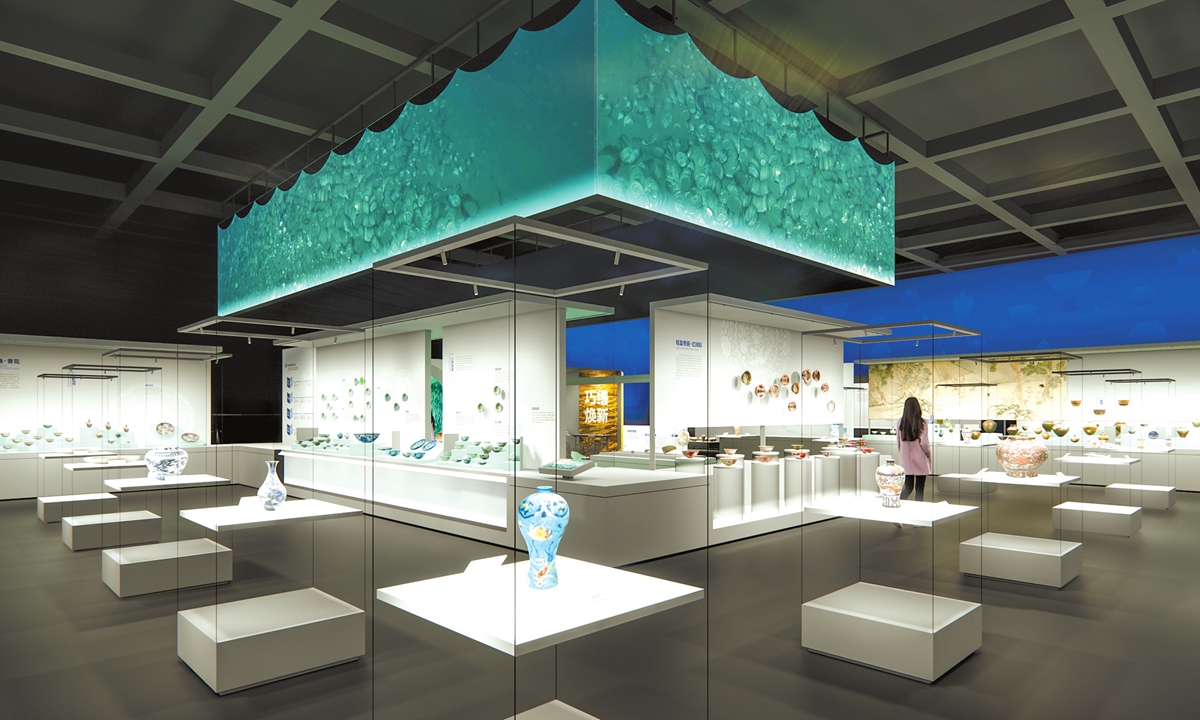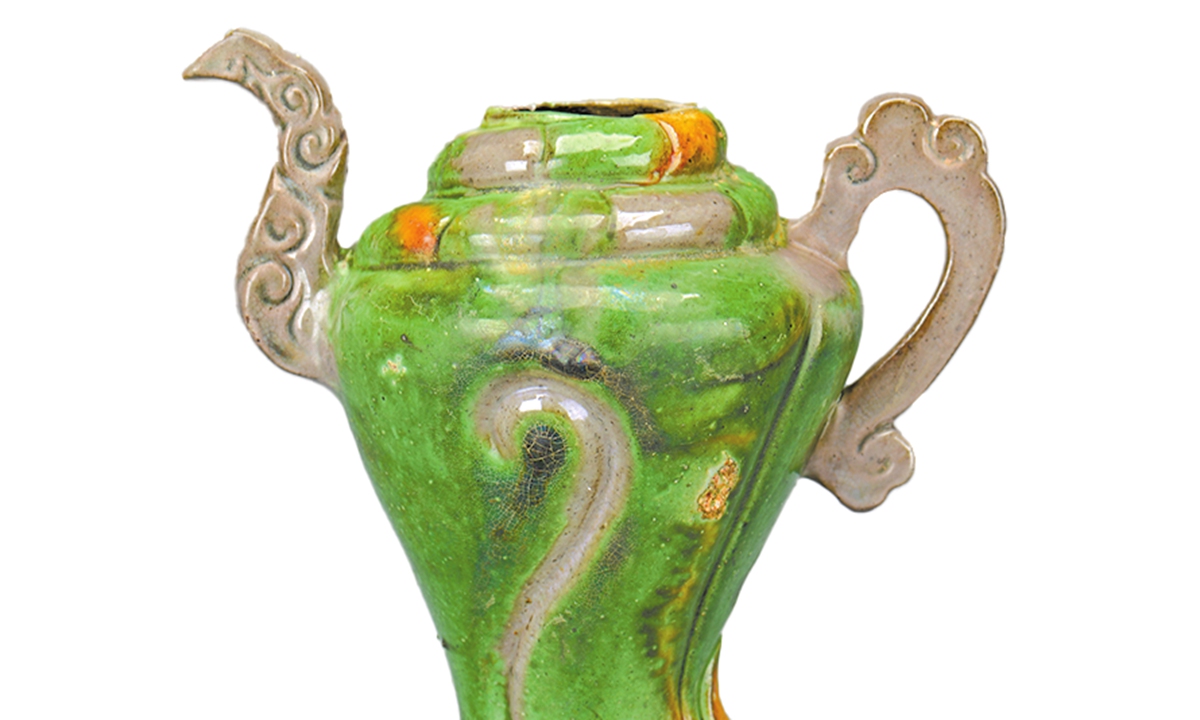
The exhibiting hall of China (Hainan) Museum of the South China Sea Photo: Courtesy of Photos: Courtesy of China (Hainan) Museum of the South China Sea
At around 1,500 meters beneath the waters on the northwest continental slope of the South China Sea, lie the remains of two merchant ships, sunk over 500 years ago. They once bore witness to the bustling trade along the ancient Maritime Silk Road.
On Wednesday, Guan Qiang, a deputy director of the National Cultural Heritage Administration (NCHA), said at a press conference that significant breakthroughs have been made in deep-sea archaeology as over 180,000 precious cultural relics have been retrieved from the No.1 shipwreck.
The underwater archaeological investigative project of the two shipwrecks, started in May 2023, has found artifacts including ceramics, bronzeware, copper coins, and bamboo and wooden items. To date, more than 900 pieces have been retrieved.
On Friday, a total of 408 artifacts recovered from the two shipwrecks, which represent some of the finest discoveries of the cultural relics, will make their first public appearance at the China (Hainan) Museum of the South China Sea.
"We hope that through this exhibition, more people will be able to learn about the important discoveries in underwater archaeology in the South China Sea, experience the historical charm of the ancient Maritime Silk Road through precious artifacts, underwater imagery, and archaeological stories, and carry forward the spirit of the Silk Road," Xin Lixue, director of the museum, told the Global Times.
First showcaseThe exhibit, occupying nearly 1,000 square meters of space, will showcase 442 items, 408 of which are from the two shipwrecks, and 34 are on loan from other institutions, such as the Palace Museum. The exhibition will offer audiences a comprehensive display of archaeological discoveries, excavation processes and technological applications.
Among the most anticipated pieces is a collection of 13
Fahua ceramics, which will be shown for the first time.
Fahua is a rare type of Chinese porcelain. Originating in the Yuan Dynasty (1279-1368) and flourishing in the Ming Dynasty (1368-1644),
Fahua porcelain items were used as court furnishings after the middle period of the Ming Dynasty.
It is the first time that
Fahua porcelain has been found in a shipwreck. These archaeological discoveries provide physical evidence of the export of Jingdezhen
Fahua porcelain during the mid-Ming Dynasty, offering valuable material for locating kiln sites and clarifying their origins.
Other notable artifacts include a red-and-green glazed bowl, which confirms that the sunken ship dates back to the Zhengde period of the Ming Dynasty and reflects the contributions of trade routes in the South China Sea during the era.
In addition to these treasures, the exhibition will offer an immersive experience, utilizing VR technology and interactive installations, allowing visitors to simulate diving to the depths of the South China Sea, exploring the shipwrecks, and witnessing the underwater excavation process through the reconstruction scenes.
The exhibit's format is set to evolve over time. As more items will be excavated and research progresses, the museum plans to update the artifacts on display and share new findings with the public, according to Yang Wu, an official from Hainan's Department of Tourism, Radio, Television, and Sports.
To complement the exhibition, a series of cultural and educational activities have been organized to enhance the experience. These include lectures, a digital "Fly Over the South China Sea" theater, and educational events centered on deep-sea archaeology. The museum has also developed a special line of cultural merchandise, drawing inspirations from the underwater archaeological work.
Archaeological milestoneThrough joint excavation efforts involving research institutes and the China (Hainan) Museum of the South China Sea over the past two years, a total of 890 relics were excavated from the first shipwreck, including porcelain and pottery pieces, as well as copper coins. From the second shipwreck, 38 ancient artifacts were retrieved, including lumber, porcelain and pottery products, turban shells, and deer antlers.
The first shipwreck was laden with export ceramics, while the second shipwreck carried imported timber, both reflecting the prosperity of maritime trade during the mid-Ming Dynasty, Song Jianzhong, head of the archaeological project and researcher at the NCHA, told the Global Times in an interview.
Notably, the
Fahua porcelain from the first shipwreck and the ebony from the second shipwreck are first-time discoveries in shipwreck archaeology.
"It is an important piece of evidence about the maritime trade along the ancient Maritime Silk Road, offering valuable materials for the study of China's maritime history, oceanic trade, and cultural exchanges between China and other countries," said Song.
The underwater archaeological work on the shipwrecks in the South China Sea marks a significant milestone, as it signifies China's underwater archaeology advancing from coastal to deep-sea exploration, Guan told media in June.
In underwater archaeology, work within 50 meters is considered regular, while depths beyond 50 meters rely on manned or unmanned submersibles and are classified as deep-sea archaeology.
The two shipwrecks on the northwestern slope of the South China Sea, located at around 1,500 meters, fall under the category of deep-sea archaeology.
The excavation was made possible through China's advanced deep-sea technology and archaeological survey equipment. For example, experts utilized 3D laser scanners and blowing devices to conduct the excavation.
"This deep-sea archaeological investigation, integrating China's deep-sea science and technology and underwater archaeology, marks the country's achievement of a world-class level in deep-sea archaeology," said Guan.

A egret-shaped pottery artifact. Photo: Courtesy of Photos: Courtesy of China (Hainan) Museum of the South China Sea





